Our Verdict
Realms of Ruin is a clumsy RTS that's devoid of Warhammer's characteristic grim darkness.
PC Gamer's got your back
Realms of Ruin, an overly simplistic RTS that focuses on low unit count skirmishes, definitely evokes the spirit of Age of Sigmar, which is unfortunately the worst version of Warhammer. It's far more forgiving than its grandiose Old World counterpart, Total War: Warhammer, but only a fraction as satisfying or interesting to play. Clumsy movement and a baffling hands-off approach to combat consign Realms of Ruin to the ever-growing graveyard of mediocre Warhammer games.
Old world blues
What is it? A casual RTS based on Warhammer: Age of Sigmar
Release date November 17, 2023
Expect to pay $60/£50
Developer Frontier Developments
Publisher Frontier Developments
Reviewed on Radeon RX 6600, Ryzen 7 5700G, 32GB DDR4 RAM
Steam Deck TBA
Link Official site
Aesthetically Realms of Ruin looks like a real game of Age of Sigmar: Sparse smears of terrain and wide open battle maps capture the too-large 6x4 foot play space of the wargame, and you'll be fielding armies that are roughly the same size and composition found in Age of Sigmar's army books. The narrative centers on a beaten down Dawnbringer Crusade regiment of the Stormcast Eternals, invading the death and destruction laden realm of Ghur to secure a powerful blah blah blah; if you've even glanced at fantasy story sideways once in your life you can figure out the rest.
The biggest issue with Realms of Ruin is fundamental to Warhammer: Age of Sigmar: The rebooted fantasy setting of the Mortal Realms is exceedingly dull, especially in contrast to the visually stunning Old World, lovingly rendered in the Total War series.
For those unfamiliar with the difference between the Old World and Mortal Realms, imagine if everything you like about Total War Warhammer got sucked into a portal (this really did happen in the lore) and then a wizard turned everyone who ever lived into a League of Legends champion. It's so high gloss, so bereft of any of the characteristic Warhammer edge and grit—if Warhammer Fantasy/40K are punk & death metal, then Age of Sigmar is Imagine Dragons. This is still the case with Realms of Ruin, especially in contrast to contemporaries Darktide and Total War: Warhammer 3, games that soak you in rich atmosphere.
The campaign is serviceable, when not bogged down by atrocious technical issues—more than once I finished a mission only to be hit with a full system crash that erased all my progress. Mission objectives are varied and offer unique twists on the "take and hold" gameplay structure, like having to simultaneously defend three awkwardly positioned ritual sites from waves of incoming ghosts, or racing to dominate a map's objectives and set up magic mortar sites to bomb a convoy. It's an inoffensive modern RTS tutorial campaign, but progress-erasing crashes and a boring narrative where you can see the ending from a hundred miles away makes Realms of Ruin tedious and frustrating to play alone.
A losing battle

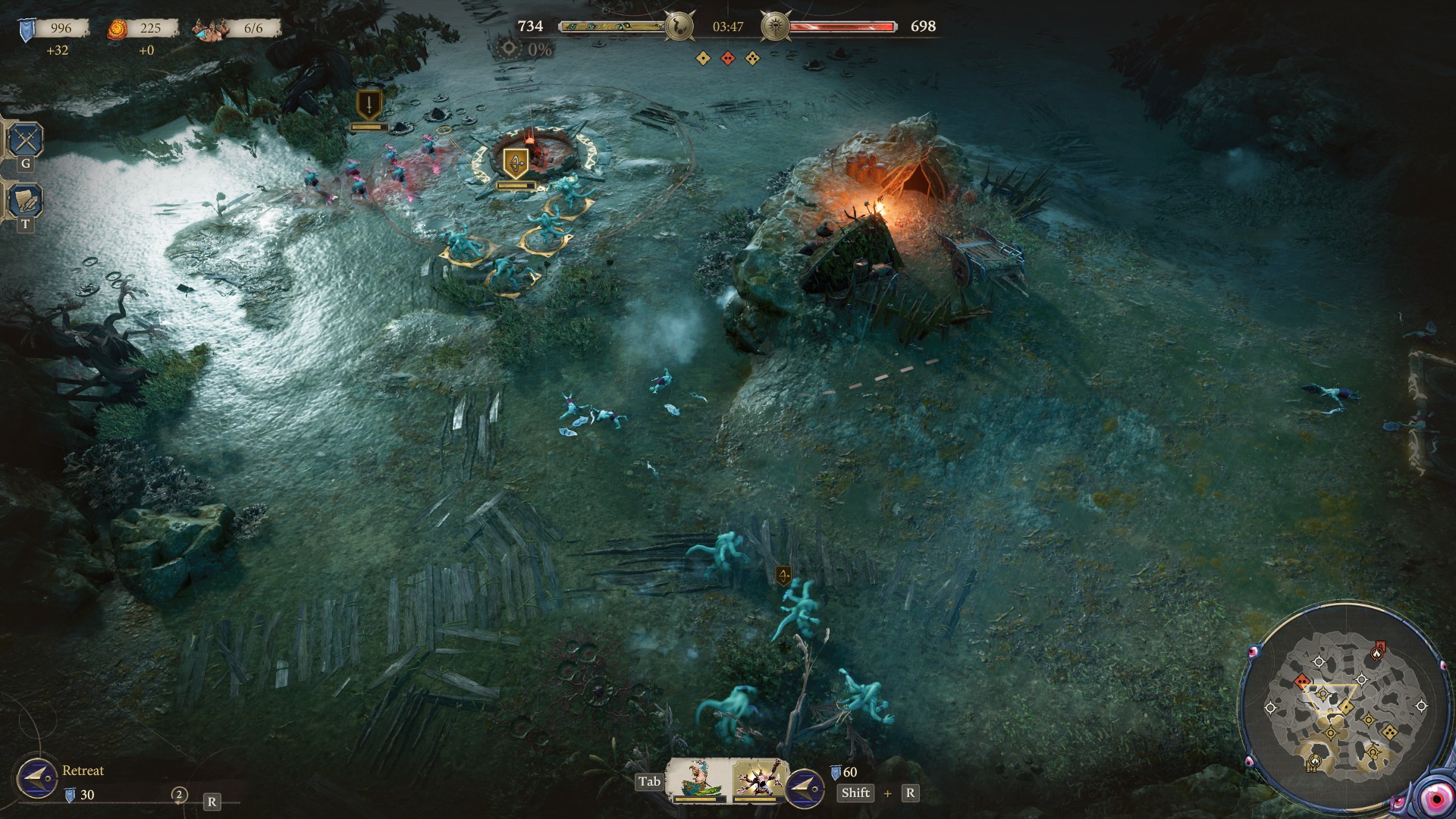
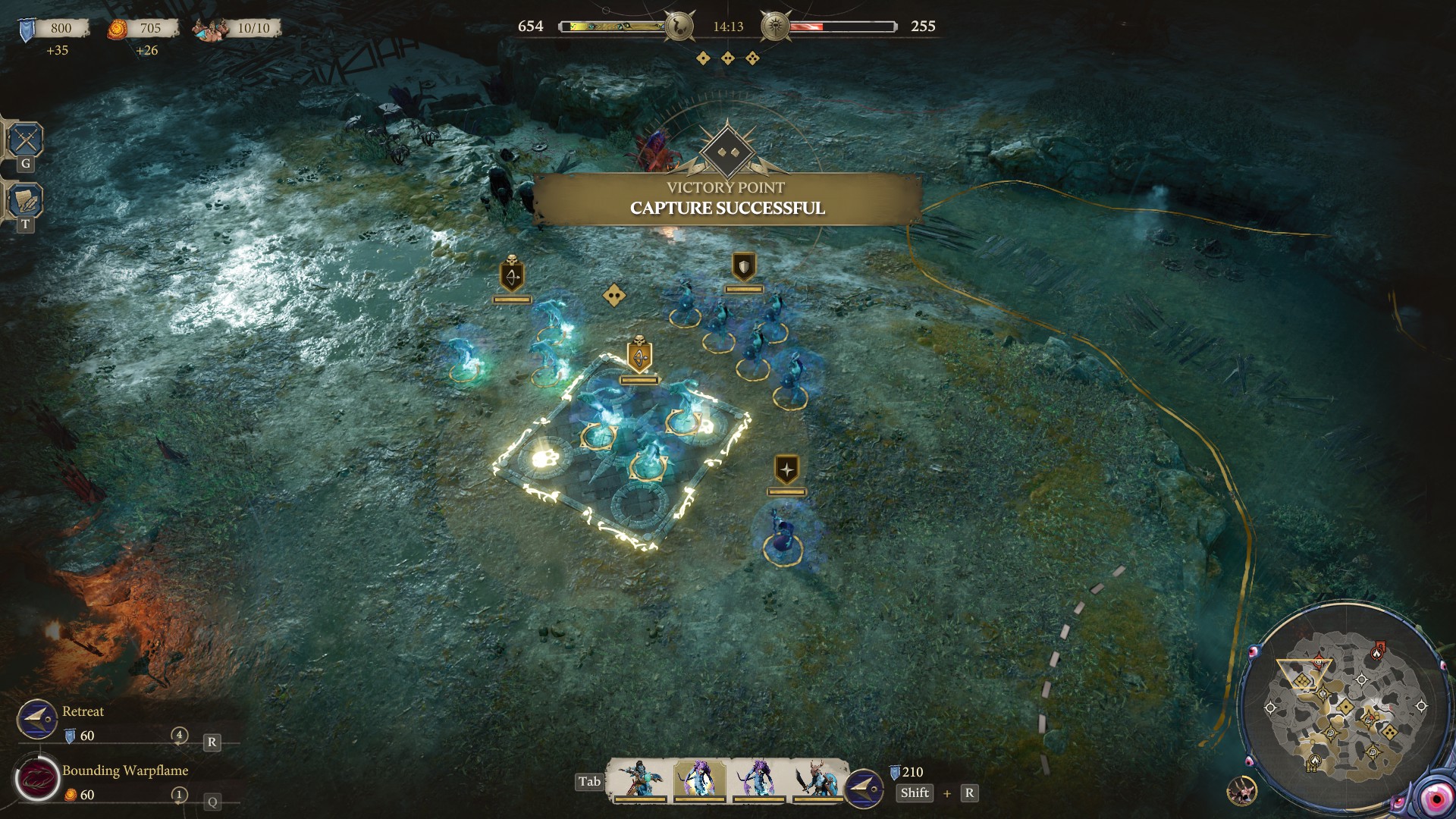

Realms of Ruin takes clear inspiration from 2009's Warhammer 40,000: Dawn of War 2 (one of the best Warhammer games), but confuses that game's successes at streamlining with oversimplification: Where Dawn of War 2's combat was massively scaled down from most RTSes, the limitations on army composition gave greater weight to the choices you made when progressing through your faction's respective upgrade tree. Smaller maps and caps on unit recruitment made the choice between a melta & plasma gun feel much more meaningful—bad unit builds could spell defeat for your forces within the first 10 minutes.
In stark contrast, Realms of Ruin's upgrade system brings no such tension or planning to the battlefield, with upgrades instead being barely noticeable "pick one" increases in damage or defense. It's especially frustrating how crucial and simultaneously useless these feel as a result of the game's other flaws.
Combat borrows an old mechanic from Warhammer's tabletop game that ends up a poor fit for an RTS: once two units lock blades, neither side can disengage until one is either defeated or retreats, an order that forces your survivors to leg it back to base and heal up. Given that you only really have agency over when your unit abilities are activated and what upgrades they head into the fray with, I found that I barely had any real control over the course of a battle.
Two armies charging in Realms of Ruin winds up looking more like a tavern brawl at the Renaissance fair due to some wonky unit pathing that will see your forces literally trip over each other. My units meant to tank damage would often get shunted out of the way by their glass cannon counterparts as they bolted to the front, eager to catch a hammer blow to the face.


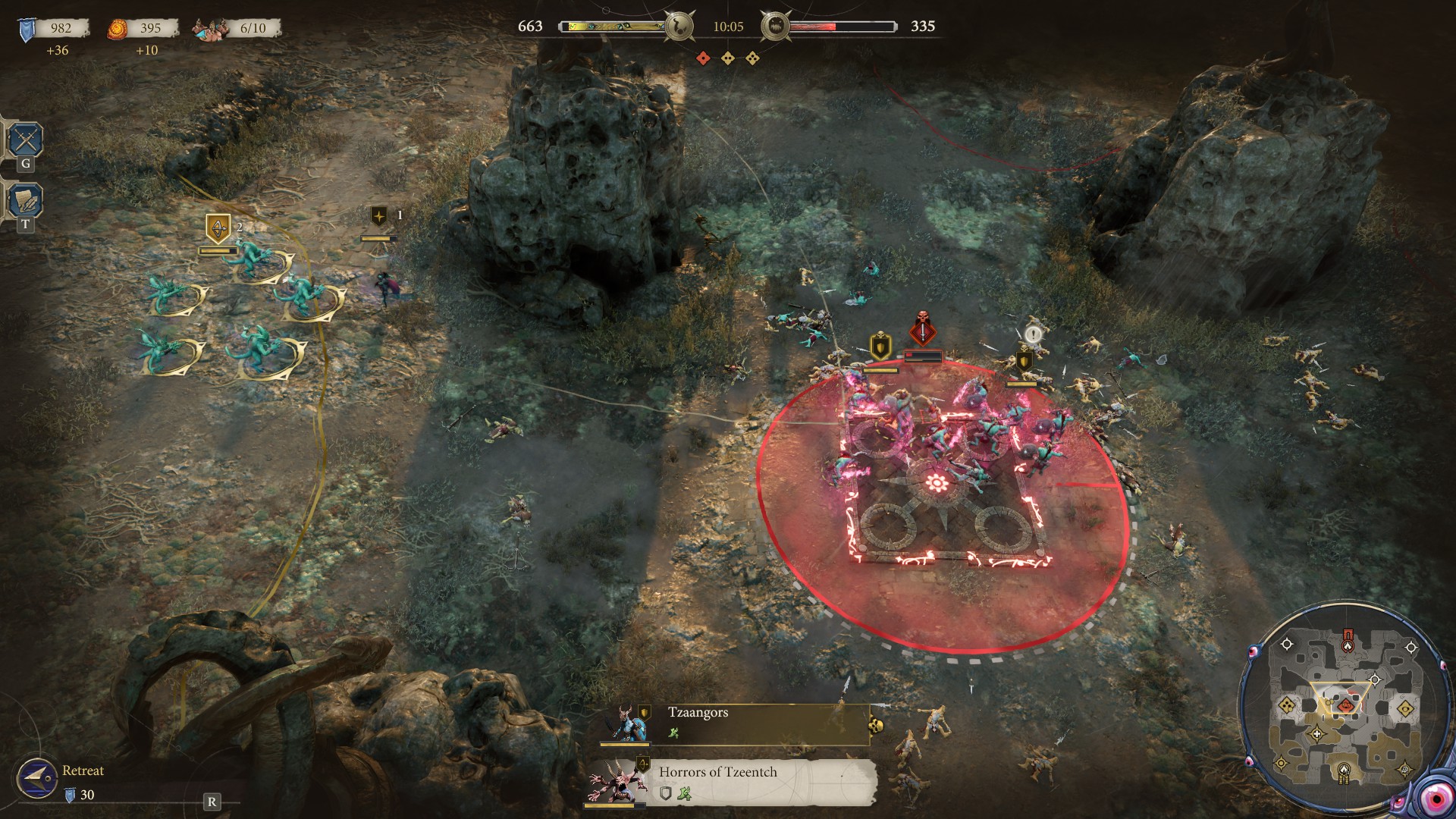
Since wounded units' only realistic avenue of healing is hanging out back at spawn, a significant amount of my playtime was dedicated to managing a high fantasy medical caravan, constantly shuffling my pawns back to the frontline. This often resulted in matches without much back and forth, where having even a fraction of my forces wiped out concurrently foretold a long, drawn-out defeat. The retreat ability key is also one of the most punishing misclicks I've experienced in an RTS—in multiplayer sessions with other PC Gamer writers, all of our leaders were constantly fleeing the battlefield by mistake. Having some kind of timer or cancelable warm-up animation would have been preferable to having our generals immediately heel turn and dead sprint back to base every couple minutes.
When our armies managed to stay on the field, battles mostly played out as incoherent mobs of gold and green smashing each other to bits. There is some avenue for more strategic play—you can capture sites that let you build a single tower that boosts one of your army's attributes. However, prioritizing these tower sites over the game-winning conquest objectives always felt like self-sabotage, mostly due to the insanely long time it takes to capture one—it's always more efficient (and way less fun) to cram a bunch of cheap basic units onto a game winning objective and buff them with a character than it is to try and play with all the cool toys available to your faction.
Realms of Ruin is almost paradoxical—why should I care about upgrades when the AI pathing will break all my formations and make tactical play all but impossible? And why should I care about strategy and tactics when I have so little ability to influence combat? After a dozen hours with Realms of Ruin, what I found is that I just didn't care about anything.
Realms, ruined
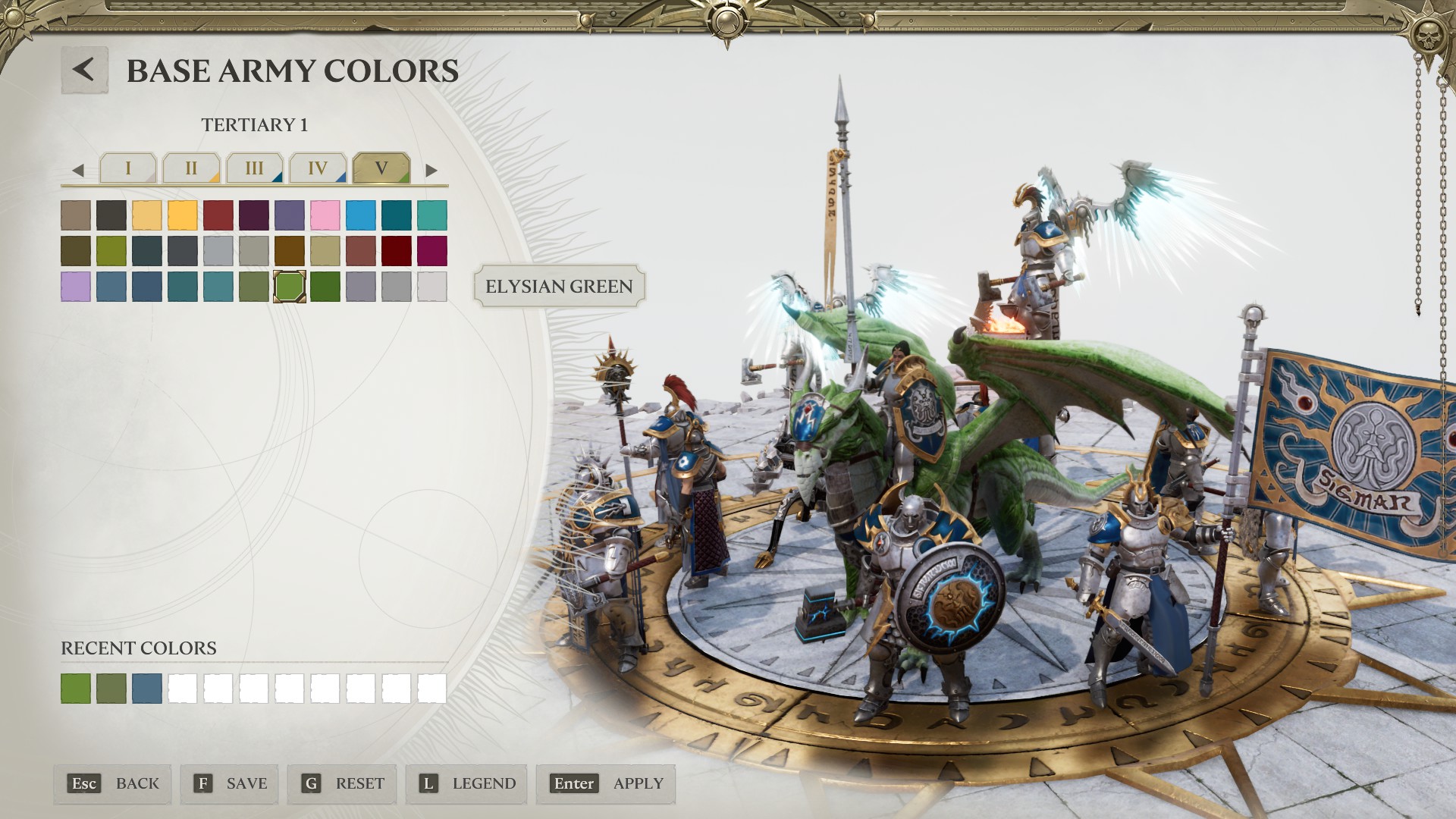
Armies do at least retain their tabletop flavor, my runaway favorite being the forces of Tzeentch, the Daemon of Change. Their emphasis on streaming ranged attacks, screening with cheap cultists and heavier daemons, and an unforgiving economy that has you racing to recruit Flamers of Tzeentch as early as possible. Two of the four factions, the horde-like Nighthaunt of Nagash and the tricky Uruk-hai-inspired Kruleboy orcs didn't grab me in quite the same way—each faction favors a specific playstyle, and Realms of Ruin's awkward movement mechanics did these unorthodox armies, which rely on tight formations and ability micro-management, no favors.
Even Warhammer's lamest setting still has some cool stuff going on, like the crunchy combat animations—Stormcast eternals, who are quite literally space marines from Warhammer 40,000 but with magic, throw their whole bodies into their hammer and ax swings, tossing out elbows and fists on the backswing. The Nazgul-esque Nighthaunt are a vexing fog of death essence, cloth, and blades, capturing the sweeping motions of the fantastic tabletop sculpts. My favourite was far and away the Lord of Change, a massive daemonic cockatrice that casts waves of iridescent magic in tsunami-sized waves.
Realms of Ruin also has an army painter—there's options for all of the official alternate army schemes featured in each respective factions' battletome, but you can also make your own schemes, complete with the full range of colors from the Citadel paint line.
I wish Realms of Ruin took some influence from PC skirmish game Moonbreaker, though. Options to add texture, shading, highlighting, and weathering would make for a more authentic recreation of the tabletop wargaming experience.
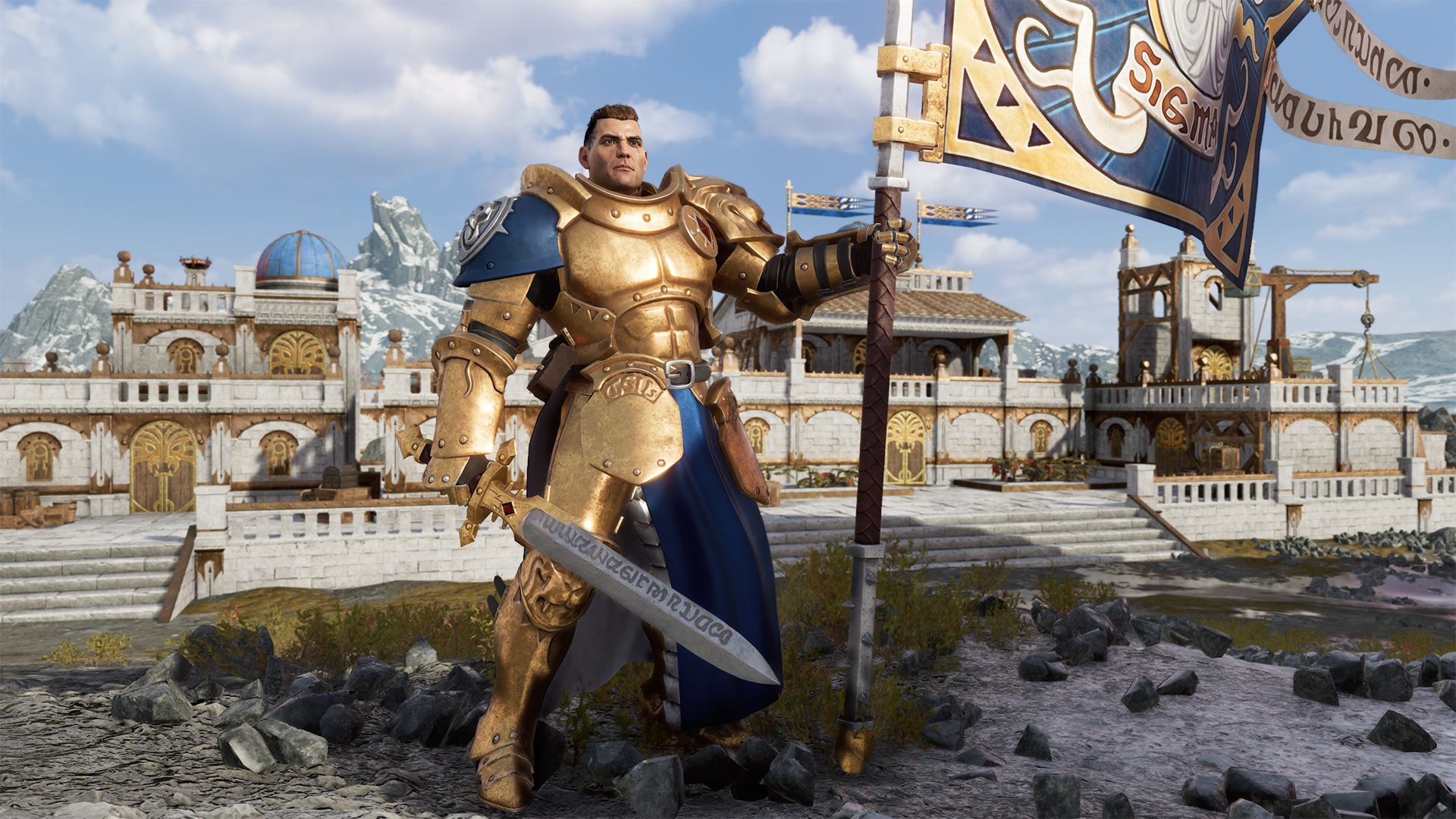
I found myself most engaged by the Conquest mode, a procedurally generated campaign that links AI skirmish battles together across a campaign map, with randomized modifiers to content with. While the ones I encountered weren't anything outrageous, modifiers like +50% movement speed & instant recruitment times papered over Realms of Ruin's shortcomings. Unlike the campaign or multiplayer, Conquest gave me freedom to experiment with new unit builds and army compositions. The most fun I had with the game was seeing how far I could get with an "Oops, all Pink Horrors!" army list (not far at all, actually).
Zoomed out from its meticulous combat animations, Realms of Ruin is an awkward, clumsy RTS that's ultimately devoid of the characteristic grim darkness that's long served as Warhammer's stylistic foundation. The bizarre combat mechanics and baffling balance strained my patience—and as a hardcore Warhammer fan, I'm very used to having my patience tested. For a more fulfilling casual Warhammer RTS, start an Immortal Empires campaign in Total War: Warhammer 3 and set the difficulty to easy.
Realms of Ruin is a clumsy RTS that's devoid of Warhammer's characteristic grim darkness.

Nova Smith is a freelance writer based out of Alberta, Canada. Nova's grab bag of non-gaming interests and passions includes Japanese mecha anime, miniature painting, as well as history, literature, and classical music. Nova also moonlights as a bureaucrat and amateur historian.


